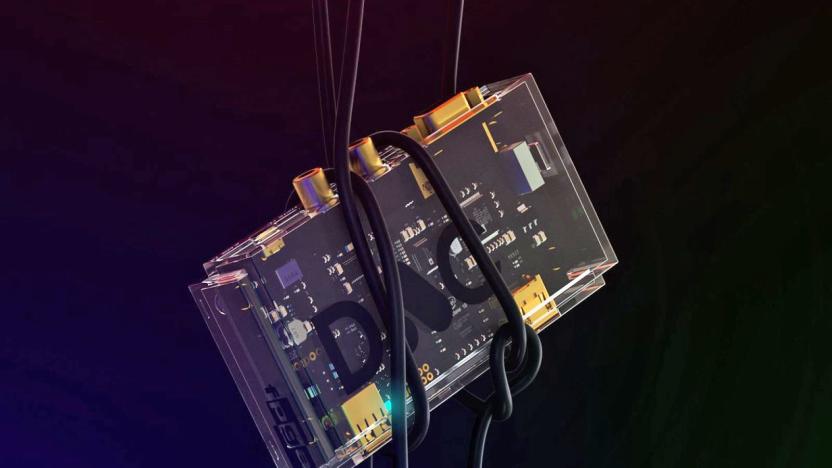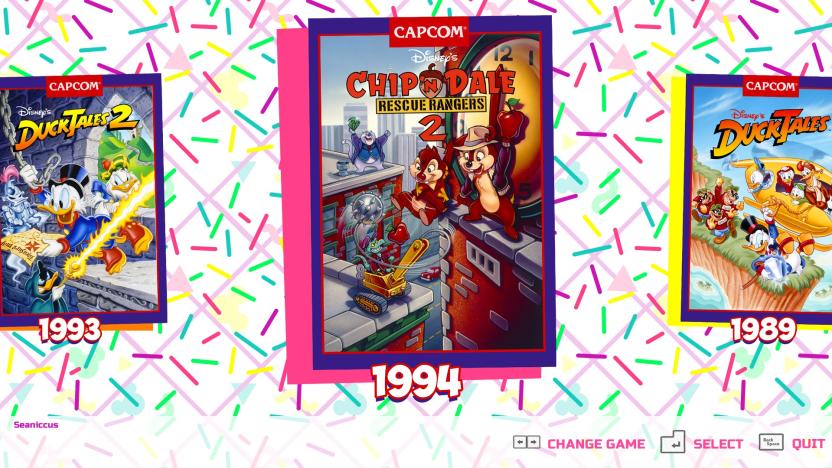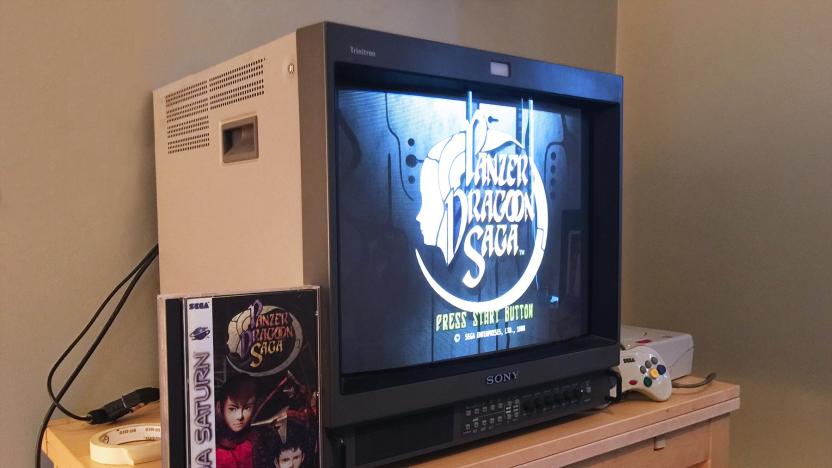crt
Latest

Analogue’s DAC lets gamers play their throwback consoles on CRT TVs
When you hear the term "DAC," you probably think of the gadgets that audiophiles use to convert digital audio data to headphone-compatible signals. Analogue's DAC, though, converts digital video data to analog signals, allowing gamers to play retro HDMI consoles (such as Analogue's own Mega Sg) on CRT TVs and analog video monitors.

Researchers create 'true' 3D holograms by trapping particles
SciFi movies like Star Wars and Avatar depict holograms that you can see from any angle, but the reality is a lot less scintillating. So far, the only true color hologram we've seen come from a tiny, complicated display created by a Korean group led by LG, while the rest are just "Pepper's Ghost" style illusions. Now, researchers from Brigham Young University (BYU) have created a true 3D hologram, or "volumetric image," to use the correct term. "We can think about this image like a 3D-printed object," said BYU assistant prof and lead author Daniel Smalley.

Capcom's collection of Disney NES games does retro gaming right
Recapturing the feeling of playing video games of bygone eras is no easy task. Sure, a simple emulator can technically drag ancient software to modern television screens, but anyone who grew up playing 8-bit games can tell you the experience isn't always the same. Pixel-perfect presentations can sometimes lack the nostalgic charm of the distorted, fuzzy tube TVs old games were originally designed for. That's one of the things that makes Capcom's Disney Afternoon Collection so special. It doesn't just collect Ducktales, Rescue Rangers and other iconic NES Disney games in convenient one package -- it wraps them in the style, context and visual limitations of the 1990s.

My pointless quest to achieve perfect retro console fidelity
It all started about four years ago when I came into an old Sega Saturn system from the mid-90s. It was an entire console catalog that I completely skipped over back in the day. I hooked it up to my TV and soon I was knee-deep in classic fighting games like Street Fighter vs. X-Men and shoot-em-ups like Thunderforce V. The low-poly art style was gorgeously retro, but I quickly realized that the image was stretched and distorted on my HDTV. I Googled "retro console fidelity," and that's where it all went wrong.

CRT-themed Super Win the Game recalls the good old days
Modern, retro-tinted platformers have got the whole "classic graphical style" thing down at this point, but emulating the warm glow of CRT TVs is a rarer feat. Minor Key Games has coated Super Win the Game in the softer presentation, pairing with open-ended, exploration-focused platforming to appear as a comprehensive throwback on PC, Mac and Linux. In case you're only willing to endure a particular amount of old-timey blur and pixelation, Super Win the Game lets players tweak the CRT-themed effects to better suit their preference. If you go for Minor Key's adventure before October 8, you can scrounge for gems and keys for $11.69 (regularly $12.99) or snatch a copy bundled with the game's soundtrack for $13.49 (normally $14.99). Super Win the Game is a sequel to Minor Key's You Have to Win the Game, a free download on PC, Mac and Linux that also emulates the screens that have hosted the countless deaths of plumbers, bandicoots and hedgehogs for decades. [Thanks, Kyle!] [Image: Minor Key Games]

Samsung, Philips, LG and others reportedly set to face EU regulatory fines for CRT price fixing
Samsung SDI, Philips, LG, Technicolor, Panasonic and Toshiba are said to be facing heavy fines from the European Commission due to alleged involvement in a TV cathode-ray tube price fixing ring. According to Reuters, the fines will be announced on November 28th and can reach up to ten percent of the turnover during the period which the cartel was said to have ran. Based on 2011 revenues, LG could be fined up to $5 billion, while Dutch-based Philips would top out at around $2.9 billion. While the fines aren't expected to reach such heights, it will definitely take more than a few Black Friday blowout sales to recover this type of coin.

InstaCRT puts all other photo filter apps to shame (video)
To hell with Instagram. Seriously. It's not that we don't understand the appeal of the photo filter standard bearer, it's just that it lacks a cleverness and visceral quality that InstaCRT has in spades. See, rather than simply recreate retro effect with some software trickery, InstaCRT actually uses the aging titular tech to achieve its goals. The concept, while clever, is actually pretty simple: you take a photo on your iPhone using the InstaCRT app, it's then uploaded to the developer where all the magic happens. Your image is displayed on a tiny 1-inch CRT (harvested from an old-school VHS camcorder) in the company's office, a picture of your photo is then taken with a fancy DSLR, and the resulting image is sent back to you. The results are monochrome, loaded with scanlines and just slightly distorted -- offering a sense of physicality that other photo filter apps just can't match. However, as clever as the concept is, it's equally inefficient and, as more people start using the app, the wait between snapping a pic and getting the finished product back, gets longer and longer. (We had to wait almost four minutes for the image above.) Still, we can't help but fall in love with InstaCRT... at least until the next photo filter app hits the market. Don't miss the video after the break, and hit up the source link to buy it now for $1.99 and see how fast we can crash the developer's servers.

The de/Rastra oscillographic synthesizer will make you wish you hadn't tossed out that old TV set
You know the old saying: one man's trash is another man's oscillographic synthesizer. The de/Rastra project from Kyle Evans takes an old CRT set and turns it into an audio / visual work of art, courtesy of four force sensing resistors, an accelerometer and several switches. Evans's goal with the project was unlocking the "capabilities intrinsic to all CRT devices" in order to "[break] down the device's 'consumption only' nature." The result is a rather spectacular performance art video. You'll be able to join in on the fun as well, as Evans plans to offer up tutorials on his hacking methods. In the meantime, you can brush up on your dance moves by checking out the video after the break.

Glove-based CRTouch project turns old monitors into touchscreens
As anyone who's ever played a game of Duck Hunt is aware, there are ways of directly interacting with CRT monitors that don't require any modifications to the display itself (a la resistive overlays). A group of students from the University of Hasselt in Belgium have now taken that idea further than most, however, and developed a glove-based system that uses a pair of phototransistors in the fingertips to detect the electron beam as it makes its way across the screen. While not quite "multitouch," the student's current setup (dubbed CRTouch) does let them draw on the screen with one finger and call up additional options (like an eraser or color palette) with the second. Head on past the break to check it out in action.

DIY CRT is fun, slightly dangerous, won't lead to a home-made TV
Looking for a DIY project with a bit more danger than an Arduino-powered TV muter, but don't have the resources to start building a fusion reactor in your garage? Well, challenge yourself with this electron accelerator project that requires little more than a wine bottle, a vacuum pump, a neon sign transformer and a diode from a microwave oven. OK, so that's not exactly a list of components you're likely to have laying around, but they're not terribly difficult to come by and at the end of the day you'll have your very own, home-made cathode ray tube. That's right, just like the one inside that TV you finally junked last week. You won't be able to create your own old-school display with it, but you will be able to observe interesting effects like sputtering (a ring of metal ion deposits) and magnetic deflection. Check out the instructions at the source and the video after the break.

Unicat retro TV channels the 1940s, bidding now underway
How does technology a half-century old manage to be this sexy? We're not certain. But this one-of-a-kind, handmade retro television -- which seemingly combines an old desktop lamp and a giant magnifying glass -- definitely tugs at our heartstrings. With a 5.5-inch monochrome CRT screen and no inputs to speak of, you won't be watching Blu-rays on this set, and its PAL standard and 220V plug mean non-Europeans might not be bothered to try. Still, for an old over-the-air TV, it's remarkably full-featured, with knobs for volume, band (VHF-L / VHF-H / UHF), brightness, contrast and V-sync, and we can't get over its clean, handsome design. If your Nixie tube collection is getting lonely, check out the auction at our source link; bidding starts at €300.%Gallery-90244% [Thanks, Alex]

LG's Classic TV gives old CRT new legs
In these complex, digital days, it's easy to yearn for simpler, analog times -- when everything was daisy-chained coax cable and all you needed was the odd RF adapter to get your gaming on. LG is taking its customers back in time with the Classic TV, an honest to gosh CRT clothed in period-appropriate attire. While it does break with tradition slightly by including a remote control, it offers nicely tactile dials and even a set of color-matched rabbit ears, making it the perfect thing for hooking up your Famicom or watching Astroboy re-runs. It's available now in Korea, your choice of basic black or cheeky red for ₩ 249,000. That equates to about $215, but don't go looking for it in your local Caldor flier.

LPD display tech from Prysm uses lasers, phosphors, groovy Flash intros
Well, it's Thursday. You know what that means: it's time for another new revolutionary display technology that will offer better image quality at lower costs and with reduced energy consumption. Today's breakthrough is LPD, or Laser Phosphor Displays. They rely on a screen covered in phosphors, much like a traditional CRT, but instead of a scanning beam of electrons those pixels are excited by a series of lasers. It seems rather similar to SED and FED tech, but with lasers rather than cathodes, thus making it roughly 23 times more awesome. The display tech is said to be able to created in any shape or size, and with its long lifespan and low power consumption is being targeted toward large-scale installations for advertising and the like. Don't believe the hype? Turn up those speakers, click on that read link, and prepare to be awed by the breathless potential of... Prysm.

1930's rear projection TV in the UK still in service
It's really easy to forget how far we've come in the past 70 or so years, while at the same time how some things stay the same. This 12-inch CRT might be the oldest working TV in the UK and has even been modified so it could be connected to a modern day converter box to gain access to Freeview -- no word if the owner is paid up on his TV license though. But what's really interesting here is that it is a rear project TV with the main mirror being mounted on fold down lid to help it blend in with the home's decor when not in use -- and to think we thought the idea of finding ways to hide HDTVs was a new idea or something.

Take a tour through Panasonic's CRT & flat panel TV recycling center
Less remarked upon in our CES 2009 coverage was the green factor consistently mentioned in many presentations, with various manufacturers promising more responsible production facilities, and plans to offer recycling for all the old televisions that will be replaced in the years to come. Courtesy of AV Watch and Google Translate, we can take a tour through one of Panasonic's recycling facilities, where the latest breakthrough uses a laser beam to separate the front and rear glass of CRTs, allowing for three times faster processing. If there's anything better than machine translation, old TVs headed for certain doom, and lasers, we have no idea what it is.

Students create CRT emulator, hope to recapture that analog gaming vibe of yesteryear
The retro gaming insurgence seems as strong as vinyl these days, but you don't see as many people looking for a CRT monitor to complete the set. More likely, they're playing a HD remake or the original title on a digital screen in more detail than the developers ever anticipated or intended. A group of Georgia Tech students are looking to change all that by modifying open-source Atari 2600 VCS emulator Stella to give players that good ole fashion analog vibe. As highlighted by associate professor Ian Bogost, key attributes such as color bleed, "burned" afterimage, RF-engendered signal noise, and texture created by the phosphor glow have been imitated here in recreating the effect. Hit up the gallery below for pictorial examples while we wait anxiously for video and / or the mod itself to rear its blurry head.

Mitsubishi's 65-inch Diamond WD-65835 RPTV HDTV reviewed
If you've been eying something a touch larger than Samsung's 61-inch HL61A650, why not consider Mitsubishi's WD-65835? The 65-inch Diamond series set was overshadowed by the altogether more intriguing LaserVue when it was introduced this Spring, but there's still a lot here worth loving. The surprisingly lightweight set was found to have accurate colors, "convincingly deep blacks" and a "bright, punchy, dimensional image," all of which sound characteristically Mitsu. Truth be told, critics had a tough time knocking the image quality at all under real-world scenarios, noting that its "exceptional contrast and solid blacks" easily trumped all but a few flat-panels. All that praise for a 65-incher under three grand? Smells like a winner if you've got the space.

Samsung's 61-inch HL61A650 RPTV HDTV reviewed
Let's face it: there aren't too many new RPTVs hitting the market these days, but for those looking to save a little coin at the expense of a little depth, Samsung's HL61A650 is worth a look. The reviewers over at Home Theater Mag were able to take this beast in for a sit-down, and overall, they were duly impressed. The 61-incher included a respectable amount of ports, sufficient picture controls, very accurate colors and a swell remote. The main knock (outside of the bulky size) was the lackluster black level; in fact, critics noted that it was "among the worst that it had measured." That aside (if you can overlook it), but HDTV was said to perform "well above its pay grade," meaning that it could be an "ideal set at the right price for the casual viewer who will leave it in Dynamic mode and watch a heavy dose of sports in a brightly lit room."

Officials urging new TV buyers to not junk their analog sets
Earlier this week we discussed the pros and cons of picking up a new digital tuner-equipped TV or simply throwing a DTV converter onto the analog set you already own. Needless to say, quite a few individuals across America will be choosing the former option, which creates quite the issue: where are all of those old sets going to go? Early on, surveys showed that people were most likely to resell it, donate it or recycle it, but we all know how easy it is to utter the politically correct response when under the microscope. In reality, there's a great chance that a large quantity of analog TVs will end up in the dump, and officials are making an eleventh hour push to encourage individuals to recycle their screen rather than clog up a nearby landfill. Given that we live here too, we'd also like to encourage the act of recycling if you're planning on ditching the old for something new -- wouldn't want the DTV conversion to be the start of the Apocalypse or something.

LCD shipments expected to skyrocket in Latin America
With DirecTV launching HD service in Latin America, we'd say it's about time its residents realized that flat-panels are the wave of the future present. According to a fresh iSuppli report, the Latin American television market is expected to make a hasty and noticeable transition between now and 2012. Reportedly, LCD TV shipments to the region are set to rise and account for over 83% of the market in under four years; meanwhile, shipments of bulky CRT sets will decline to make up around 8% of the total market. The numbers are pretty baffling when you consider that CRTs held 77.4% of the market just last year, and it's actually rather scary to think where all of those soon-to-be-unwanted sets will end up.












